2 x Blue Diamond Angelfish Pterophyllum scalare mix male female, Beautiful Tropical Fish for Your Freshwater Tank, Enhancing Aesthetic Appeal and Harmony
£32.99 Original price was: £32.99.£28.00Current price is: £28.00.
Welcome these beautiful Blue Diamond Angelfish, a stunning mix of male and female Pterophyllum scalare. Perfect for enhancing your freshwater tank, these elegant tropical fish thrive in harmonious environments, bringing vibrant colors to your community aquarium. Ideal for peaceful companions.
Species Introduction
The Blue Diamond Angelfish, scientifically known as Pterophyllum scalare, belongs to the family Cichlidae and is one of the most captivating species of freshwater angelfish. These beautiful tropical fish are native to the Amazon River Basin, where they inhabit slow-moving waters, swamps, and floodplains. Their natural habitat is characterized by dense vegetation, which provides them with both shelter and hunting grounds. The Blue Diamond variety is particularly prized for its striking appearance, featuring a shimmering blue body that can appear almost iridescent under the right lighting conditions. This species typically reaches a maximum length of 15 cm (approximately 6 inches) and is known for its graceful swimming patterns, making it a popular choice among aquarists looking to enhance the aesthetic appeal of their freshwater tanks.
Essential Care Guide for Your 2 x Blue Diamond Angelfish Pterophyllum scalare mix male female
| Optimal Living Conditions | |
|---|---|
| Water Temperature | 24-27°C (75-81°F) |
| pH Level | 6.5-7.5 |
| Water Hardness | 4-12 dKH |
| Minimum Tank Size | 80L (20 gal) |
| Salinity | Freshwater |
| Care Level | Beginner Friendly |
Caring for Blue Diamond Angelfish requires a balanced approach to their environment and diet. It is essential to provide them with a spacious tank that allows for swimming and hiding. As a general rule, a minimum tank size of 75 liters (20 gallons) is recommended for a pair, ensuring they have adequate space to establish territories. The water parameters should be closely monitored; a pH range of 6.0 to 7.5 is ideal, along with a temperature range of 24°C to 28°C (75°F to 82°F) to mimic their natural habitat. The hardness of the water should be maintained between 3 to 10 dGH, which is conducive to their health and well-being.
Natural Behavior & Temperament
Blue Diamond Angelfish are known for their peaceful demeanor, making them excellent community fish. They exhibit a unique swimming pattern that is both graceful and mesmerizing, often gliding through the water with ease. In a well-maintained aquarium, these fish tend to be sociable and can coexist harmoniously with other peaceful species. However, they can exhibit territorial behavior, especially during breeding periods, and may require ample space and hiding spots to establish their territories. Observing their interactions with tank mates can be a rewarding experience, as they display a range of social behaviors, from playful swimming to gentle nipping during courtship rituals. It is essential to choose compatible tank mates to ensure a peaceful environment.
Tank Setup Guide
Creating an ideal environment for your Blue Diamond Angelfish involves careful consideration of tank setup. Begin with a spacious aquarium that provides plenty of swimming room and hiding spots. Use a soft substrate, such as sand or fine gravel, to mimic their natural habitat and reduce stress on their delicate fins. Incorporate live plants like Amazon swords, Java ferns, and Anubias to create a lush environment that offers shelter and breeding sites. Additionally, include driftwood and rocks to provide hiding places and territorial boundaries. Ensure that the tank has a gentle filtration system to maintain water quality without creating strong currents, as angelfish prefer calm waters. Proper lighting is also crucial; aim for a moderate light level to encourage plant growth while avoiding excessive brightness that can stress your fish.
Water Quality Management
Maintaining optimal water quality is paramount for the health of your Blue Diamond Angelfish. Regular water changes of 20-30% weekly are recommended to keep nitrate levels low and ensure a clean environment. Monitor the pH, temperature, and hardness regularly using reliable test kits. The ideal pH for these fish ranges from 6.0 to 7.5, with a temperature between 24°C and 28°C (75°F to 82°F). Hardness should be maintained between 3 to 10 dGH to ensure their comfort. Additionally, consider using a quality water conditioner to remove harmful chemicals from tap water before adding it to the tank. Establishing a stable environment with minimal fluctuations in water parameters will help prevent stress and promote the overall well-being of your aquatic companions.
Feeding & Nutrition
✓ Diet: Varied diet including flakes, pellets, and live foods
Feeding Schedule: 2-3 times a day, small portions
Providing a balanced diet is essential for the health and vibrancy of your Blue Diamond Angelfish. They thrive on a varied diet that includes high-quality flakes, pellets, and occasional live or frozen foods such as brine shrimp, bloodworms, and daphnia. Aim to feed them 2-3 times a day in small portions, ensuring that all food is consumed within a few minutes to prevent water quality issues. A well-rounded diet will not only enhance their coloration but also support their overall health and vitality. Additionally, consider incorporating spirulina and other plant-based foods to provide essential nutrients and promote healthy digestion.
Compatibility Guide
When selecting tank mates for your Blue Diamond Angelfish, it is crucial to choose species that are peaceful and compatible. Ideal companions include other community fish such as tetras, rasboras, and peaceful barbs. Avoid aggressive species or those that may nip at the fins of your angelfish, as this can lead to stress and health issues. Additionally, consider the size and temperament of potential tank mates; smaller, more timid fish may become targets for bullying. Providing ample hiding spots and territories will help reduce aggression and create a harmonious community tank. Regularly observe interactions among your fish to ensure a peaceful environment.
Health & Wellness
✓ Common Issues: Ich, fin rot, and stress-related diseases
Prevention: Maintain water quality and provide a balanced diet
Keeping your Blue Diamond Angelfish healthy requires vigilance and proactive care. Common health issues include ich, fin rot, and stress-related diseases, which can arise from poor water quality or inadequate nutrition. To prevent these problems, it is essential to maintain stable water parameters and provide a balanced diet rich in nutrients. Regularly inspect your fish for signs of illness, such as changes in behavior, appetite, or physical appearance. If you notice any abnormalities, consult a veterinarian or aquatic specialist for guidance on treatment options. Prompt action can often prevent minor issues from escalating into serious health concerns.
Breeding Information
Breeding Blue Diamond Angelfish can be a rewarding experience for aquarists. To encourage spawning, provide a separate breeding tank with stable water parameters and ample hiding spots. The ideal breeding environment should include flat surfaces for egg-laying, such as smooth rocks or broad-leaved plants. When ready to breed, the female will lay eggs, typically numbering in the hundreds, which the male will fertilize. After spawning, the parents will often guard the eggs and fry, providing protection from potential threats. Once the fry hatch, they require infusoria or finely crushed flakes for nourishment until they are large enough to consume larger foods. Monitoring the breeding pair and their offspring closely will ensure a successful breeding process.
Acclimation Process
Introducing your Blue Diamond Angelfish to a new tank requires a careful acclimation process to minimize stress. Begin by floating the sealed bag containing the fish in the aquarium for about 15-20 minutes to equalize the temperature. After this, gradually introduce small amounts of tank water into the bag over the next hour. This process helps the fish adjust to the new water parameters. Once acclimated, gently release the angelfish into the tank, avoiding the addition of bag water to prevent contamination. Monitor the fish closely for signs of stress or illness during the first few days in their new environment.
Long-term Care
Caring for Blue Diamond Angelfish is a long-term commitment that requires ongoing attention to their environment and health. These fish can live for several years, often reaching an age of 10 years or more when properly cared for. Regular maintenance of the aquarium, including water changes, substrate cleaning, and plant care, is essential to their longevity. Additionally, continue to monitor their health and behavior, adjusting their diet and environment as needed. As they grow, be prepared to adapt their living conditions to accommodate their changing needs, ensuring a thriving and harmonious aquatic community.
Natural Habitat Recreation
Recreating the natural habitat of Blue Diamond Angelfish in your aquarium is vital for their well-being. Mimicking the Amazon River Basin involves using soft substrates, such as sand or fine gravel, along with an array of live plants to provide shelter and foraging opportunities. Incorporate driftwood and rocks to create hiding spots and territorial boundaries, which are essential for their comfort and security. The lighting in the tank should be moderate to promote plant growth while providing a natural ambiance. By replicating their natural environment, you can help reduce stress and encourage natural behaviors in your aquatic companions.
Seasonal Care Adjustments
As seasons change, so too should your care routine for Blue Diamond Angelfish. During warmer months, ensure that the water temperature remains stable and does not exceed the upper limit of their preferred range. Consider using fans or chillers if necessary. In colder months, maintain the water temperature with heaters, ensuring that it remains within the ideal range of 24°C to 28°C (75°F to 82°F). Additionally, adjust lighting durations to mimic natural day/night cycles, which can influence breeding and behavior. Seasonal changes in water parameters should be monitored closely, and regular maintenance should continue to ensure a healthy environment.
Expert Tips
✓ Professional Advice: Monitor water quality regularly
Consider using a high-quality water conditioner
For optimal care of your Blue Diamond Angelfish, consider implementing the following expert tips: Regularly monitor water quality using reliable test kits to ensure parameters remain stable. Invest in a high-quality water conditioner to remove harmful chemicals from tap water, promoting a safe environment for your fish. Additionally, consider using a high-quality aquarium filter to maintain water clarity and quality. Regularly inspect your fish for signs of stress or illness, and be proactive in addressing any issues that arise. Creating a thriving environment for your aquatic companions requires dedication, but the rewards of watching them flourish are immeasurable.
Troubleshooting
If you encounter issues with your Blue Diamond Angelfish, it is essential to identify the root cause promptly. Common problems include stress, disease, and aggression from tank mates. Stress can often be alleviated by ensuring a stable environment, providing ample hiding spots, and maintaining proper water quality. If you notice signs of illness, such as lethargy or loss of appetite, consult a veterinarian or aquatic specialist for guidance on treatment options. Aggression from tank mates can often be mitigated by rearranging the tank layout to disrupt established territories. Regular observation and quick action can prevent minor issues from escalating into significant health concerns.
Scientific Background
The Blue Diamond Angelfish is a fascinating species with a rich scientific background. As a member of the family Cichlidae, they share a lineage with many other popular aquarium fish. Their scientific classification places them within the order Cichliformes, which encompasses a diverse range of species known for their complex behaviors and social structures. Research into angelfish has revealed insights into their breeding habits, social interactions, and environmental needs. Understanding their scientific background not only enhances our appreciation for these beautiful creatures but also informs best practices for their care and conservation in captivity.
Advanced Care Techniques
For those looking to deepen their knowledge of Blue Diamond Angelfish care, advanced techniques can enhance their living conditions and health. Consider implementing a breeding program to observe their natural reproductive behaviors and contribute to the conservation of this stunning species. Additionally, experimenting with aquascaping can create a more dynamic environment that encourages natural behaviors, such as foraging and hiding. Regularly participating in online communities and forums can provide valuable insights and tips from experienced aquarists, helping you refine your care techniques and ensure the well-being of your aquatic companions.
Water Quality Parameters
Optimal Range
24-27°C
6.5-7.5
0 ppm
Caution Zone
22-24°C or 27-29°C
6.0-6.5 or 7.5-8.0
0.25-0.5 ppm
Danger Zone
<22°C or >29°C
<6.0 or >8.0
>0.5 ppm
Monitoring Tip: Test water parameters weekly and perform regular water changes to maintain optimal conditions for your aquatic friends!
Frequently Asked Questions
Q: What tank size is required for Blue Diamond Angelfish?
The recommended tank size for Blue Diamond Angelfish is at least 100 litres (approximately 26 gallons). Angelfish require ample swimming space and a well-planted environment to thrive. A larger tank helps to reduce territorial disputes, especially when housing a pair. Additionally, ensure the tank is adequately filtered and has a secure lid, as angelfish are known to jump. A spacious tank not only enhances their health and well-being but also allows for a natural display of their stunning colours and behaviours.
✓ Expert Tip
Consider adding floating plants to provide shade and create a more natural habitat for your angelfish.
Q: What water parameters do Blue Diamond Angelfish require?
Blue Diamond Angelfish thrive in water with a temperature range of 24-28°C (75-82°F), a pH level between 6.5 and 7.5, and a hardness of 3-8 dGH. Maintaining stable water conditions is crucial, as fluctuations can lead to stress and illness. Regular water testing and partial water changes (about 25% weekly) can help keep the environment healthy. Additionally, ensure the water is well-filtered and free of toxins, as angelfish are particularly sensitive to poor water quality.
✓ Expert Tip
Utilise a reliable water conditioner to remove chlorine and chloramines from tap water before adding it to the aquarium.
Q: How often should I feed Blue Diamond Angelfish?
Feed your Blue Diamond Angelfish 2-3 times a day with small portions they can consume within a few minutes. A varied diet is essential for their health; include high-quality flakes, pellets, and occasional frozen or live foods such as brine shrimp or bloodworms. Overfeeding can lead to poor water quality and health issues, so it is crucial to monitor their intake. Adjust the feeding schedule as needed, especially during breeding periods, as they may require more nutrition during this time.
✓ Expert Tip
Incorporate vegetable matter into their diet, such as spirulina flakes, to promote optimal health and colouration.
Q: What are the best tank mates for Blue Diamond Angelfish?
When selecting tank mates for Blue Diamond Angelfish, it is essential to choose peaceful species that do not nip at their fins. Suitable companions include tetras, rasboras, and larger species of snails. Avoid aggressive fish or small, fin-nipping species, as they can stress the angelfish. Additionally, ensure the tank is spacious enough to accommodate the different species without overcrowding, as this can lead to territorial behaviour and stress. Monitoring interactions during the initial introduction is crucial to ensure harmony.
✓ Expert Tip
Introduce new fish gradually to minimise stress and observe their behaviour closely during the acclimatisation period.
Q: How do I properly acclimatise Blue Diamond Angelfish to my aquarium?
Acclimatising Blue Diamond Angelfish is vital to ensure their health and minimise stress. Begin by floating the sealed bag containing the fish in your aquarium for about 15-20 minutes to equalise the temperature. Then, gradually introduce tank water into the bag over another 30-45 minutes. This can be done by adding small amounts of water from the tank into the bag every 10 minutes. Finally, gently place the fish into the aquarium using a net to avoid adding any transport water, which may contain harmful substances.
✓ Expert Tip
Maintain the aquarium’s lights off for the first few hours after introducing the fish to reduce stress.
Q: What are the signs of a healthy Blue Diamond Angelfish?
Healthy Blue Diamond Angelfish exhibit vibrant colours, active swimming patterns, and a good appetite. Their fins should be extended and free of tears or fraying. Observe their behaviour; they should interact with other fish and explore their environment. Any signs of lethargy, loss of colour, or abnormal swimming behaviour may indicate stress or illness. Regular monitoring and maintaining optimal water conditions can significantly contribute to their overall health.
✓ Expert Tip
Keep a close eye on their behaviour during feeding times, as a decreased appetite can be an early indicator of health issues.
Q: How do I successfully breed Blue Diamond Angelfish?
Breeding Blue Diamond Angelfish requires a suitable environment with a separate breeding tank. The water should be slightly acidic, warmer (around 28-30°C), and very clean. Provide flat surfaces for spawning, such as broad leaves or breeding cones. A pair will typically lay eggs on these surfaces, which the male will fertilise. After hatching, the fry can be fed infusoria or finely crushed flakes. Regular water changes and maintaining optimal conditions are crucial during this period to ensure the health of the fry.
✓ Expert Tip
Consider using a separate breeding tank to reduce stress and protect the fry from potential predators.
Q: What is the lifespan of Blue Diamond Angelfish?
In captivity, Blue Diamond Angelfish typically live for 10 to 15 years when provided with optimal care. Factors that influence their lifespan include water quality, diet, and tank conditions. Regular maintenance, such as water changes and monitoring for diseases, can significantly enhance their longevity. Additionally, a stable environment with appropriate tank mates contributes to their overall well-being.
✓ Expert Tip
Consider keeping a detailed log of water parameters and feeding schedules to track their health over the years.
Q: What type of substrate is most suitable for Blue Diamond Angelfish?
For Blue Diamond Angelfish, a soft substrate like sand or fine gravel is ideal. This type of substrate is gentle on their delicate fins and allows for natural behaviour, such as foraging. Additionally, it provides a suitable environment for beneficial bacteria, which helps maintain water quality. Avoid sharp substrates that could injure your fish. Layering the substrate with some live plants can also enhance the aesthetic appeal of the aquarium.
✓ Expert Tip
Incorporate plants and decorations to create hiding spots and reduce stress for your angelfish.
Q: What behavioural patterns should I expect from Blue Diamond Angelfish?
Blue Diamond Angelfish exhibit a range of interesting behaviours. They are generally peaceful but can display territoriality, especially during breeding. You may observe them swimming gracefully in the tank and establishing their territory by displaying their fins. They often enjoy exploring their environment, so providing plants and decorations encourages natural behaviour. It is essential to monitor their interactions with tank mates to ensure compatibility and reduce stress.
✓ Expert Tip
Observe your angelfish regularly to become familiar with their normal behaviour, making it easier to spot any signs of distress or illness.
Q: How can I prevent common diseases in Blue Diamond Angelfish?
Preventing diseases in Blue Diamond Angelfish involves maintaining high water quality and a stable environment. Regular water changes and testing for ammonia, nitrite, and nitrate levels are crucial. Quarantine new fish before introducing them to the main tank to prevent the spread of diseases. Additionally, providing a varied diet helps strengthen their immune system. Observe your fish closely for any behavioural changes, as early detection is key to effectively addressing health issues.
✓ Expert Tip
Consider using aquarium salt as a preventative measure against certain diseases, but ensure it is safe for all tank inhabitants.
Q: What lighting conditions do Blue Diamond Angelfish prefer?
Blue Diamond Angelfish thrive in moderate lighting conditions. Bright lights can cause stress and discomfort, so it is advisable to use subdued lighting or provide shaded areas with plants or decorations. A light cycle of around 10-12 hours per day mimics natural conditions and promotes healthy growth of any live plants in the tank. Additionally, consider using LED lights, as they can provide adequate illumination while being energy efficient.
✓ Expert Tip
Utilising a dimmer switch can allow you to adjust the light intensity according to the needs of your aquarium.
Q: How do I recognise stress in Blue Diamond Angelfish?
Signs of stress in Blue Diamond Angelfish may include erratic swimming, hiding excessively, or displaying faded colours. They may also exhibit rapid gill movement or clamped fins. Changes in feeding behaviour, such as a lack of interest in food, can also indicate stress. Monitoring water parameters and ensuring a peaceful environment with compatible tank mates can help alleviate stress. If you observe these signs, it is critical to reassess their living conditions and make necessary adjustments.
✓ Expert Tip
Creating hiding spots with plants or decorations can provide a sense of security for your angelfish, helping to reduce stress.
Q: What natural habitat conditions should I replicate for Blue Diamond Angelfish?
Blue Diamond Angelfish are native to the Amazon River basin, where they inhabit slow-moving waters with plenty of vegetation. To replicate their natural habitat, provide a well-planted tank with ample hiding spots using driftwood and plants. Maintaining slightly acidic to neutral pH and warm temperatures, alongside gentle filtration, will help create a comfortable environment. Mimicking these conditions not only supports their health but also encourages natural behaviours and enhances their overall well-being.
✓ Expert Tip
Consider using natural materials for decorations to create a more authentic and comforting environment for your angelfish.

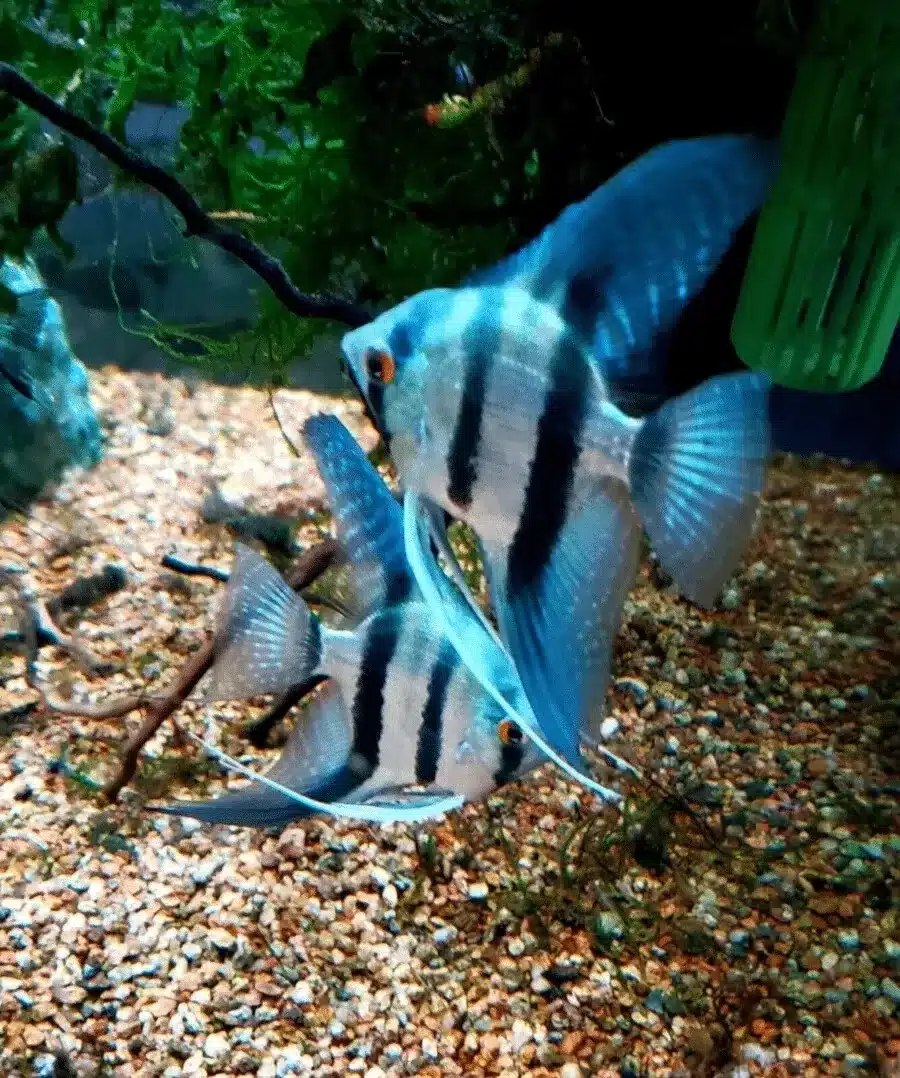
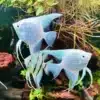

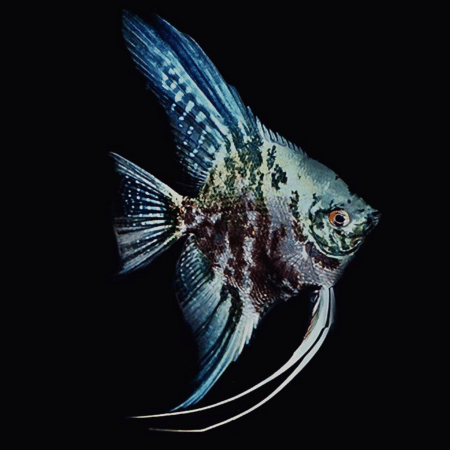

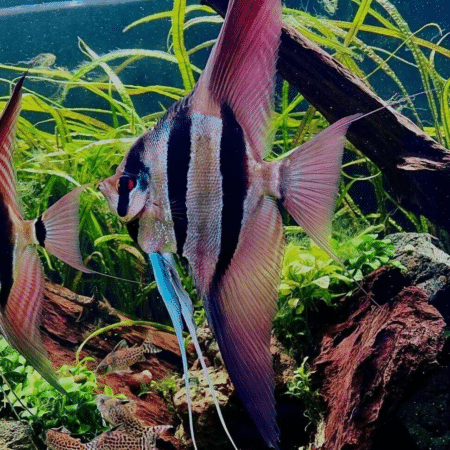
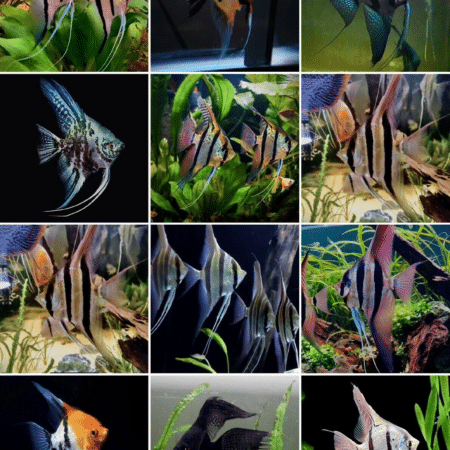
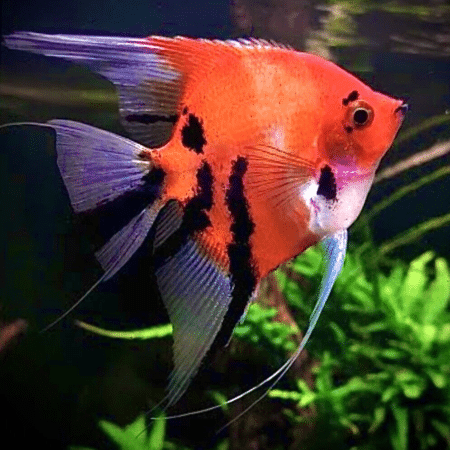

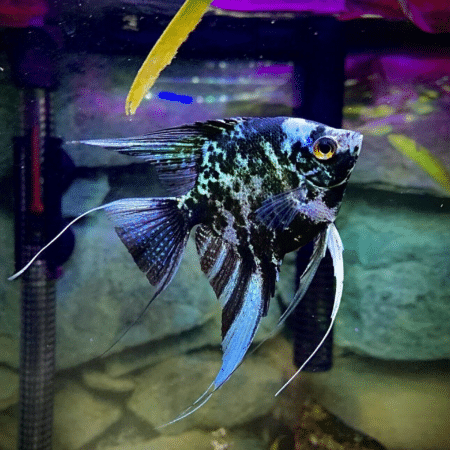

Jessica Turner (verified owner) –
I recently added 2 Blue Diamond Angelfish (mix male and female) to my freshwater aquarium, and I couldn’t be happier! After about three weeks, these beauties have truly transformed my tank. Their shimmering blue scales are breathtaking, and their behavior is so captivating to watch. I’ve had other angelfish before, but this particular mix seems to thrive in my environment, showing a delightful blend of curiosity and playfulness. They dart around during feeding, and it’s a joy to see them interact with the other fish.
The shipping was impressively fast, and they arrived in perfect condition—healthy and active! One small concern was their initial shyness; it took a few days for them to fully acclimate and come out more. However, patience paid off as they’ve now established their territory and are quite the confident duo!
I would highly recommend these angelfish to anyone looking to liven up their aquarium. They add so much personality and beauty! If you have a peaceful tank environment, these angelfish will thrive and enchant you just as they have for me. Truly a wonderful addition to any aquarist’s collection!
Emily Carter (verified owner) –
I recently added two Blue Diamond Angelfish to my freshwater tank, and I couldn’t be more thrilled! These beautiful tropical fish have transformed my aquarium into a vibrant underwater paradise. They were packaged safely for shipping and arrived in perfect health, which is so important for maintaining fish welfare.
After about a week of acclimation, I noticed how well they interact with my other fish, creating a harmonious environment. Their shimmering scales and graceful movements add elegance to the tank, and watching them has become my favorite pastime! Compared to previous angelfish I’ve owned, this mix of male and female has shown such a charming dynamic that I didn’t expect.
One minor concern was their initial shyness; it took a couple of days for them to fully come out of their shells, but now they are bold and curious. I highly recommend these Blue Diamond Angelfish for anyone looking to enhance their aquarium’s aesthetic appeal. They are perfect for both novice and experienced aquarists who prioritize fish happiness. I can’t wait to see how they continue to thrive in my tank!